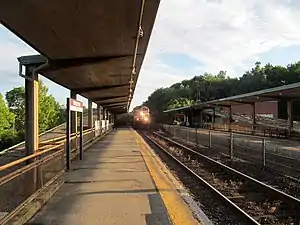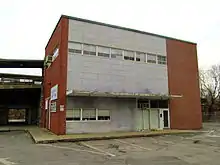Winchester Center station
Winchester Center station is an MBTA Commuter Rail station in Winchester, Massachusetts. It serves all Lowell Line trains as well as a limited number of Haverhill Line trains which run via the Wildcat Branch. It is located on a viaduct in downtown Winchester. Winchester Center station is not accessible, but the MBTA plans to renovate the station and add accessible high-level platforms. The station was closed effective January 8, 2021 due to deterioration.
Winchester Center | |||||||||||||||
|---|---|---|---|---|---|---|---|---|---|---|---|---|---|---|---|
 An outbound train at Winchester Center station in August 2015 | |||||||||||||||
| Location | 29 Waterfield Road Winchester, Massachusetts | ||||||||||||||
| Coordinates | 42.4516°N 71.1378°W | ||||||||||||||
| Line(s) | New Hampshire Main Line | ||||||||||||||
| Platforms | 2 side platforms | ||||||||||||||
| Tracks | 2 | ||||||||||||||
| Connections | |||||||||||||||
| Construction | |||||||||||||||
| Parking | 237 spaces (town permit required) | ||||||||||||||
| Bicycle facilities | 27 spaces | ||||||||||||||
| Other information | |||||||||||||||
| Fare zone | 1 | ||||||||||||||
| History | |||||||||||||||
| Closed | January 8, 2021 | ||||||||||||||
| Rebuilt | Planned | ||||||||||||||
| Passengers | |||||||||||||||
| 2018 | 456 (weekday average boardings)[1] | ||||||||||||||
| Services | |||||||||||||||
| |||||||||||||||
| |||||||||||||||
History

The Boston and Lowell Railroad opened between its namesake cities in 1835; local stops including Winchester were added soon after.[2][3] By the 1840s, service on the line was suitable for commuting to Boston.[2]
In the early 1950s, the B&M began planning a project to raise the tracks of the New Hampshire Main and the southern end of the Woburn Branch for a mile through Winchester, eliminating troublesome grade crossings downtown.[4] Construction began in 1955; boxy two-story brick stations opened at Wedgemere and Winchester Center in 1957.[3][5]
Until 1981, the Woburn Branch diverged from the main line just north of the Winchester Center platforms. A short stub is still in place.[6]
Repair work

Winchester Center station has not been substantially renovated since the viaduct was completed in 1957. In September 2008, the MBTA approved $1.4 million in platform and ramps repairs, as well as electrical and lighting work, at the station.[7] The work was completed in 2010; the MBTA intended to renovate the station before the 5-year life of the platform patches was reached.[8]
On July 7, 2015, the Winchester Department of Public Works discovered a hole in the inbound platform, which prompted the closure of the northern 500 feet (150 m) of the platform and one ramp due to concrete deterioration. One ramp and the remaining section of the platform remained open for service. The MBTA planned to make temporary repairs before the end of the year.[8] Further repairs were made in 2017 to support the platforms and ramps.[9]
Planned renovations
The MBTA is planning renovations to the station which will repair water damage and make it fully accessible. The station design was advanced to 15% in December 2011; Jacobs Engineering was then chosen as the contractor for final design in June 2012.[10] Funding issues prevented this design work from beginning until 2013.[10] It was later determined that the mini-high platforms of the 15% design were not sufficient for state accessibility requirements, and that full-length high-level platforms would be required. The town objected to simply changing the design to accommodate these platforms.[10]
After several iterations, a new 15% design was reached in December 2015. The rebuilt station will have 724-foot (221 m)-long high-level platforms; although shorter than the 800-foot (240 m) MBTA standard, they will still be able to platform 9 cars. A gauntlet track may be installed to allow Pan Am Railways freight trains to pass.[10] A new interlocking may be built south of the station, which will allow greater flexibility during construction and allow the retirement of the former Woburn Branch interlocking north of the station after completion.[10] Although early designs called for replacement of existing ramps, the new 15% design added two redundant elevators at the southern end of each platform. The 1957-built station will be demolished to make room for the elevators and staircases.[10] The northern ramp to the outbound platform will be moved north of the adjacent rotary; the northern inbound ramp will be rebuilt at its present location south of the rotary, with the possibility of an additional ramp north of the rotary in the future.[10]
Design of the station was then expected to be completed by the end of 2016, with the $25.8 million construction beginning in 2017.[11][10] By October 2016, bidding was expected to begin that December.[12] The MBTA designated $34 million in funding in 2016, but the projected cost rose to $54 million by 2018.[13] By late 2019, the total project budget was $49.9 million: $7.3 million for design and $42.5 million for construction.[14]
By May 2020, the MBTA expected to begin construction in fall 2020, with completion in spring 2023.[15] However, the project was put on hold in 2020 due to budgetary issues caused by the COVID-19 pandemic.[16] The station was closed effective January 8, 2021 due to deterioration.[17][18] On January 11, the MBTA reinstated funding for the project due to the closure.[19] The MBTA received a demolition permit on January 25.[20]
References
- Central Transportation Planning Staff (2019). "2018 Commuter Rail Counts". Massachusetts Bay Transportation Authority.
- Karr, Ronald Dale (1995). The Rail Lines of Southern New England. Branch Line Press. pp. 229–231. ISBN 0942147022.
- Humphrey, Thomas J. & Clark, Norton D. (1985). Boston's Commuter Rail: The First 150 Years. Boston Street Railway Association. pp. 55–57. ISBN 9780685412947.
- "Winchester Overpass Cost Boosted to $6,000,000". Boston Globe. October 21, 1953. p. 14 – via Newspapers.com.

- Roy, John H. Jr. (2007). A Field Guide to Southern New England Railroad Depots and Freight Houses. Branch Line Press. p. 260. ISBN 9780942147087.
- Belcher, Jonathan. "Changes to Transit Service in the MBTA district" (PDF). NETransit.
- "Agenda for September 11, 2008 Board Meeting". Massachusetts Bay Transportation Authority. 11 September 2008. Retrieved 3 August 2008.
- Berkowitz, Bram (15 July 2015). "Winchester Center MBTA stop partially closed". Wicked Local Winchester.
- "Train station temp repairs". Daily Times Chronicle. July 28, 2017.
- Jacobs Engineering (December 2015). "MBTA Winchester Center Station Renovation Project: 15% Design Report". Massachusetts Bay Transportation Authority.
- LaRoche, Ryan (29 January 2016). "MBTA commuter rail project ongoing". Daily Times Chronicle. Retrieved 24 February 2016.
- "Future Construction Contract Bid Solicitations". Massachusetts Bay Transportation Authority. October 2016. Archived from the original on October 14, 2016.
- Manzhos, Mariya (June 7, 2018). "Winchester Commuter Rail station is falling apart, but MBTA funding is still up in the air". Wicked Local Winchester.
- "Winchester Center Station Improvements Public Meeting" (PDF). Massachusetts Bay Transportation Authority. November 21, 2019.
- Brelsford, Laura (May 26, 2020). "SWA Initiatives—May 2020" (PDF). pp. 7–8.
- Brelsford, Laura (November 30, 2020). "System-Wide Accessibility Initiatives—November 2020" (PDF). Massachusetts Bay Transportation Authority Department of System-Wide Accessibility. p. 7.
- "Lowell Line Alerts". Massachusetts Bay Transportation Authority. January 7, 2021. Archived from the original on January 8, 2021.
- Ellement, John R.; Sennott, Adam (January 8, 2021). "Winchester Center commuter rail closed due to structural problems". Boston Globe. Retrieved January 9, 2021.
- "Winchester Center station project gets green light". Daily Times Chronicle. January 12, 2021. Retrieved January 13, 2021.
- "MBTA gets demo permit for Winchester Center Commuter Rail Station". Daily Times Chronicle. January 26, 2021. Retrieved February 3, 2021.
External links
| Wikimedia Commons has media related to Winchester Center station. |